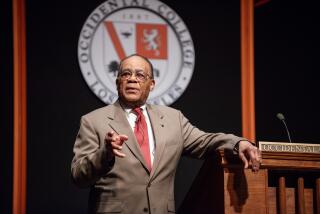John Cornforth dies at 96; Nobel Prize-winning chemist
The difference between a glove for the left hand and one for the right is obvious to the human eye, even though the two are mirror images of each other. It is an easy task to distinguish between them and separate them from each other.
Most biological molecules have similar mirror images, but it can be difficult to distinguish between them and even harder to separate them. Hardest of all is synthesizing only the desired form, because only this form will interact with other biological molecules in the correct fashion. The enzymes that construct all the components of cells perform this difficult task routinely, but chemists in the laboratory have found it extremely difficult.
One of the first scientists to demonstrate how this so-called stereospecific synthesis occurs was the Australian chemist John W. Cornforth. Working in England in the 1960s, Cornforth used radioactive isotopes to trace the route by which cells convert acetic acid — the primary constituent of vinegar and a simple molecule containing only two carbon atoms — into cholesterol, a crucial cellular component containing 27 carbon atoms.
That feat provided the blueprint for subsequent generations to elucidate biological reaction pathways and won Cornforth the 1975 Nobel Prize in Chemistry and a knighthood.
Cornforth, 96, died Dec. 14 in Sussex, England, according to news reports in his native Australia.
“We owe much of today’s chemistry to his pioneering research,” said Roger Ainsworth, Master of St. Catherine’s College at Oxford University where Cornforth graduated. He “was one of the mid-20th century giants of organic chemistry,” added chemist William Jorgensen of Yale University.
His successes required him to overcome obstacles that weren’t faced by many other Nobel laureates.
John Warcup Cornforth Jr. was born in Sydney, Australia, on Sept. 7, 1917, and was raised in Sydney and rural New South Wales. He began losing his hearing at the age of 10 as a result of a genetic condition called otosclerosis, in which bones in the ear become overgrown and nonfunctional.
He had originally intended to study law, but a high school teacher steered him toward chemistry, where his deafness would be less of a problem. At 14 he had already begun performing experiments in a laboratory assembled in his mother’s laundry room.
By the time Cornforth entered Sydney University at the age of 16 he could not hear any of the lectures and was forced to absorb most of the knowledge through textbooks. Unfortunately, most chemistry texts at the time were written in German, so he had to teach himself that language as well. Nonetheless, he graduated with first-class honors and a University Medal.
During his academic career, he never heard a visiting lecturer, but was able to perceive the gist through their slides and blackboard writings. Nonetheless, colleagues noted that he usually asked the most incisive questions.
Scientific glassware was at a premium in Australia during this period, so Cornforth also learned glass-blowing. For most of his later life, he was known by the nickname “Kappa” because he inscribed that Greek letter on his glassware to identify it.
Another Sydney chemistry student named Rita Harradence accidentally broke the neck off one of her flasks and was told by friends to take it to Cornforth for repair. They became a couple and, when they graduated in 1937 — he with a bachelor’s degree and she with a master’s — they independently won a prestigious prize that allowed them to enroll at Oxford University. They were married in 1941 when both completed their doctorates and worked together throughout their careers, co-authoring 41 research papers.
After graduation, they remained at Oxford and helped in the chemical synthesis of the new antibiotic penicillin, which was vital to the war effort. He later wrote “The Chemistry of Penicillin,” a record of that massive international effort.
After the war, Cornforth joined the National Institute for Medical Research, first at Hampton and then at Mill End. By 1951, he had completed the first total synthesis of non-aromatic steroids.
In 1962, Cornforth and colleague George Popjak left to become codirectors of the Milstead Laboratory of Chemical Enzymology established by Shell Research. It was there that he carried out most of his research on the synthesis of cholesterol.
In 1975, he moved to the University of Sussex, where he spent the rest of his career. During that year, he also received his Nobel. The Nobel committee, which normally attempts to explain each awardee’s research in a press release for the media, noted that his work “is difficult to explain to the layman as it is a question of geometry in three dimensions.” The committee noted that the award deals with “how the shape of a molecule … is created, and how this affects its behavior.”
Two years later, Cornforth was knighted. He also received virtually every other major award presented in chemistry.
In his last visit to Australia in 1992, Cornforth modestly commiserated with chemistry students who, he said, have it much harder than he did. “When Rita and I were learning our chemistry here, chemistry was not really very difficult,” he noted. “There was not really all that much to know. Now I am sorry for all you people because there really is a lot to know.”
Cornforth’s wife of 71 years died in 2012. He is survived by two daughters, a son, two grandchildren and four great-grandchildren.
More to Read
Start your day right
Sign up for Essential California for the L.A. Times biggest news, features and recommendations in your inbox six days a week.
You may occasionally receive promotional content from the Los Angeles Times.






